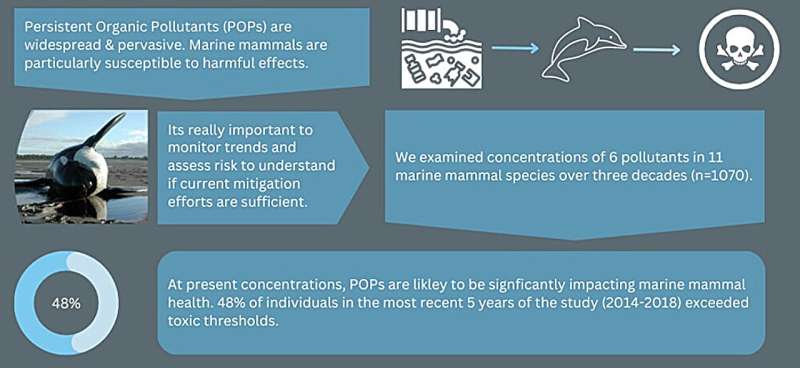Thirty years of data show persistent organic pollutants remain a threat to marine biodiversity

A team of zoologists, environmental scientists, marine biologists and life scientists affiliated with several institutions in Ireland and the U.K. has found that despite international bans, persistent organic pollutants (POPs) continue to be both widespread and pervasive in the environment, including the world's oceans.
In a new study published in Environmental Science & Technology, the research team pulled data from several studies involved in tracking large sea creatures, fish and the ocean in general to learn more about the level of POPs in sea creatures that live at the top of the food chain.
Prior research has shown that there are many types of POPs and that some of them can be hazardous to both humans and animals. Polychlorinated biphenyls (PCBs), for example, negatively impact reproduction in many creatures. PCBs have been banned by most countries since the Stockholm convention in 2004. Still, the researchers note, they have remained in the environment and continue to harm creatures that consume them.
For this new study, the research team looked at PCB levels in marine species that live at the top of the food chain, such as whales and dolphins. Prior research has shown that these species tend to build up levels of POPs because of biomagnification.
To learn more about PCB levels in whales and dolphins, the researchers studied records for 1,000 large marine mammals that became stranded in the U.K. over a 30-year period. The data, which included 11 marine mammal species, came from several databases built by groups monitoring the sea and its inhabitants.
The research team found that overall, levels of POPs found in the marine animals were lower than observed in prior studies, suggesting that levels in the sea are dropping. But they note also that a serious threat remains. They found, for example, that orcas had on average 30 times the levels of PCBs in their blubber than is considered to be safe. They also found that 47% of tissue samples from marine mammals collected over the past five years had PCB levels considered to be toxic.
More information: Rosie S. Williams et al, Spatiotemporal Trends Spanning Three Decades Show Toxic Levels of Chemical Contaminants in Marine
Mammals, Environmental Science & Technology (2023). DOI: 10.1021/acs.est.3c01881
Journal information: Environmental Science & Technology© 2023 Science X NetworkBaby dolphins found to receive high doses of persistent organic pollutants from their mothers' milk
No comments:
Post a Comment